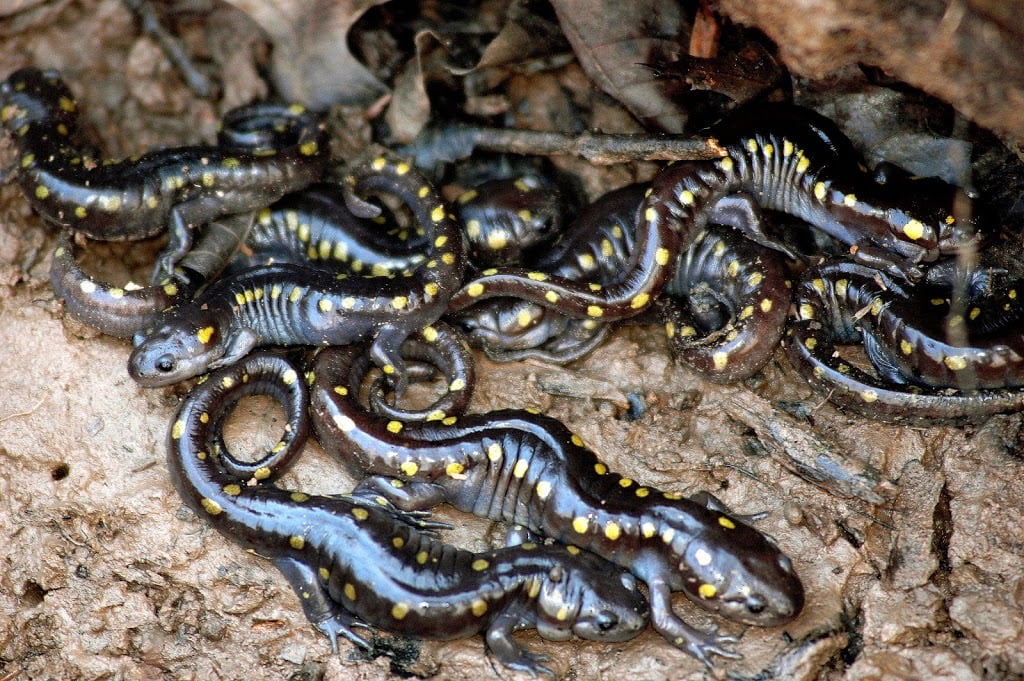What animal group is called a congress? A congress is a group of salamanders, ravens or crows. A group of salamanders can also be referred to as a herd just as many grazing quadrupedal ungulates such as cattle, deers and elephants are called.
Some specific species of salamanders are called newts while the overall scientific name for the salamander group is ‘Urodela’ or ‘Caudata’.
For ravens and crows
The collective noun for ravens can also be a murder, a horde, a muster and a cauldron meanwhile that of crows can also include a murder, a horde or an unkindness of crows.
What a congress isn’t
From the context above, it is clear that a congress is a group of salamanders, ravens or crows. What a congress isn’t however is a large gatherings of baboons as popularised by different kinds of memes all over the internet. The proper collective noun for dozens or even hundreds of baboons is a ‘troop’ or ‘flange’.
Outdated
One important thing to note is that most of these terms of venery fell out of use after the 16th century, including the congress of salamanders and murder for crows. Many were never even used in the first place and were only popularized by specific groups of people.
Only a handful of collective nouns are recognized today by people and scientists around the world. Some of the most popular group names include: herds for grazing ungulates and pride or pack for larger groups of carnivorous animals.
Definitions
Congress: The term congress means a large formal meeting of representatives from different places (countries or regions) in which ideas are discussed and information is exchanged.
Herd: A herd is a social gathering of wild or domestic animals of the same species, especially of mammals, and even they, of grazing quadrupedal ungulate mammals that display this behaviour.
The term can also be used for birds. A herd usually but not always has a control animal (or leader) that is not always dominant in conflict situations but most frequently is. Often, wild herds are regularly subjected to predation from pack hunters such as wolves and lions (or rather, carnivores).
Quadrupedal: Animals that are four footed and use all four feet to walk and run.
Ungulate: All mammals with hooves on their legs such as horses and pigs.
Interesting facts about salamanders
Salamanders are animals that resemble a cross between lizards and toads. They scientifically belong to the modern group of amphibians (such as frogs and toads) and are mostly pronounced in the Holarctic ecozones of the world although some species live and thrive in the south american continent. Here are some quick and interesting facts about salamanders.
Interesting facts about salamanders
- Salamanders resemble lizards in their external morphology but they are actually members of the amphibian group: closely related to frogs and toads that they are with reptiles like lizards and snakes.
- Salamanders can be aquatic, semi-aquatic or terrestrial based.
- Most salamanders have moist and smooth skin but a handful of species have rough skins that is wet to the touch. Some species lack pigments in their skin and as a result have colorless, translucent pink or pearlescent appearance. Some have very dull colors, while other species can have bright coloration with various patterns of spots, bars, stripes, blotches, or dots.
- Salamanders can be as small as an inch and as giant as 1.8 meters including tail length. The average length however falls between 20 to 30 cm.
- Salamanders have clawless limbs, and some species, especially the aquatic ones can have reduced or absent hind legs; giving them the impression of an eel.
- Salamander can use their tails for locomotion in trees, for jumping or for propulsion while mating. In some terrestrial species, the tail serves as means of support and in most species, as a defense mechanism; through lashing continuously at the predator or self amputating it when grabbed to allow the salamander to quickly escape the predator. The tail when autotomised also dangles continuously on the ground to distract the predator and give more time for the salamander to secure safety.
- Salamanders shed their skins and often eat their sloughed skin after shedding.
- Salamanders with very bright warning colorations on their bodies (often a mixture of colored spots with black for contrast), have very powerful toxins on their skins that can be deadly to humans and other animals when ingested even in minute fragments.
- Salamanders can hear, smell and see (although some species are effectively blind), but do not have a voice. Even though they don’t have a voice, some species are still able to produce sound by moving and utilizing structures within their bodies.
- Salamanders are capable of regenerating their lost body parts i.e tails, limbs and other complex body parts such as lens or retinas.
- Salamanders can breath through lungs, gills, skin or any combination of these structures depending on the species.
- Salamanders eat crabs, fish, small mammals, amphibians, and aquatic insects. Some species can turn cannibal when food resources become scarce, often preying on distantly related individuals.
- Salamanders have teeth, even their larvae (embryo) do.
- Salamanders use their slimy bodies to avoid predation. Some species develop offensive tasting or toxic skins to ward off or kill predators and virtually all can sacrifice their tails to distract predators. Some species can even squirt toxins at their aggressors.
- One specie of salamander known as the eastern newt salamander can survive for up to 30 minutes after being swallowed by snakes or birds.
More interesting articles
- What animal has the longest tongue?
- What animal has the most teeth?
- What do you call a group of turkeys?
Cite this Article ” (APA Format)
Bunu. M. (2020, July 11). What animal group is called a congress?. Retrieved from http://emborawild.com/animal-group-called-congress/

